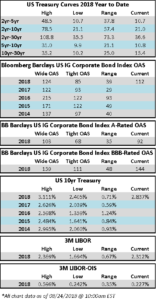CAM Investment Grade Weekly Insights
CAM Investment Grade Weekly
08/24/2018
Investment grade corporate spreads were essentially unchanged in what was a relatively quiet week for the credit markets.
According to Wells Fargo, IG fund flows for the week of August 16-August 22 were +$1.9 billion. IG flows are now +$90.456 billion YTD.
Per Bloomberg, $8.25 billion of new issuance printed during the week. This paltry figure for issuance was unsurprising, as the last two weeks of August are typical very quiet on the issuance front. August as a whole, however, has been fairly active all things considered, with $75bln of issuance so far in the month. Bloomberg’s tally of YTD total issuance stands at $771.934bn.

(Bloomberg) Utilities May Still Choose to Retire Coal, Not Upgrade Under EPA Plan
- Upgrade or retire. The choice for coal-fired plants under the Trump EPA’s new power sector proposal isn’t that different from what they faced under the Obama-era carbon controls the plan would replace.
- But even with the Environmental Protection Agency’s attempts this time around to pave the way for more coal plant upgrades, many state regulators and utilities still may look to invest more of their dollars in cleaner burning natural gas and renewable energy instead.
- That is because the reduced upgrade costs coal-fired plants might see due to a proposed change in EPA air pollution permitting requirements may not outweigh the low cost of natural gas.
- Still, even if just a relatively small number of older plants stay online as a result of the rule, the carbon dioxide and other pollution they put into the atmosphere would be damaging, critics of the plan say.
- “In some states there will be inertia to extend the life of enough coal plants that it’s worth worrying about if you remember that this is supposed to be a response to climate change,” Joseph Goffman, former senior counsel in the EPA’s air office during the Obama administration, told Bloomberg Environment.
- Low natural gas and falling renewable energy prices may pull utilities toward the direction of retiring aging coal. But a proposed change to the EPA’s new source review program, tucked in the broader Trump plans, could allow plants to add these technologies while bypassing new pollution control requirements.
- Under new source review, companies must install controls when they expand or add new facilities that significantly increase emissions of air pollutants such as nitrogen oxides, particulate matter, and sulfur dioxide. The EPA is proposing to assess any emissions increase, historically measured on an annual basis, by also using an hourly rate—a change that could mean power plants could run longer and therefore emit more pollution without triggering requirements to control their emissions.
- The change “has the potential to change the calculus for these coal plants close to retiring and on the fence,” Meredith Hankins, the Shapiro Fellow in Environmental Law and Policy at UCLA, told Bloomberg Environment. They’ve been “handed this opportunity to upgrade their equipment.”
- In many cases, making a plant more efficient and allowing it to run longer could help a company’s bottom line, though it would depend on each plant’s situation, Michael Goo, regulatory counsel for the Institute of Clean Air Companies, which represents makers of pollution-control equipment, told Bloomberg Environment at the Baltimore conference.
(Bloomberg) American, United Jump as Airline Investors Bet Worst Behind Them
- American Airlines Group Inc. led a surge in U.S. airline stocks as investors bet that strong travel demand and lower fuel prices will help carriers extend a rebound following the industry’s first-half rout.
- Jet fuel prices have settled below $2.20 a gallon in recent weeks after climbing as high as $2.28 in May. Scheduled talks between China and the U.S. hold out the prospect of easing trade tensions and therefore a better outlook for business trips. And airlines have vowed to slow expansion plans in an effort to raise prices by paring growth in the seat supply.
- In an interview Monday, American’s president, Robert Isom, said the company is already seeing “great signs” of progress in its efforts to increase sales, cut costs and improve product offerings.
- “We know we can do better and we’re doing everything we can to accelerate the initiatives we have out there,” Isom said. “We are seeing great signs that they are taking root.”